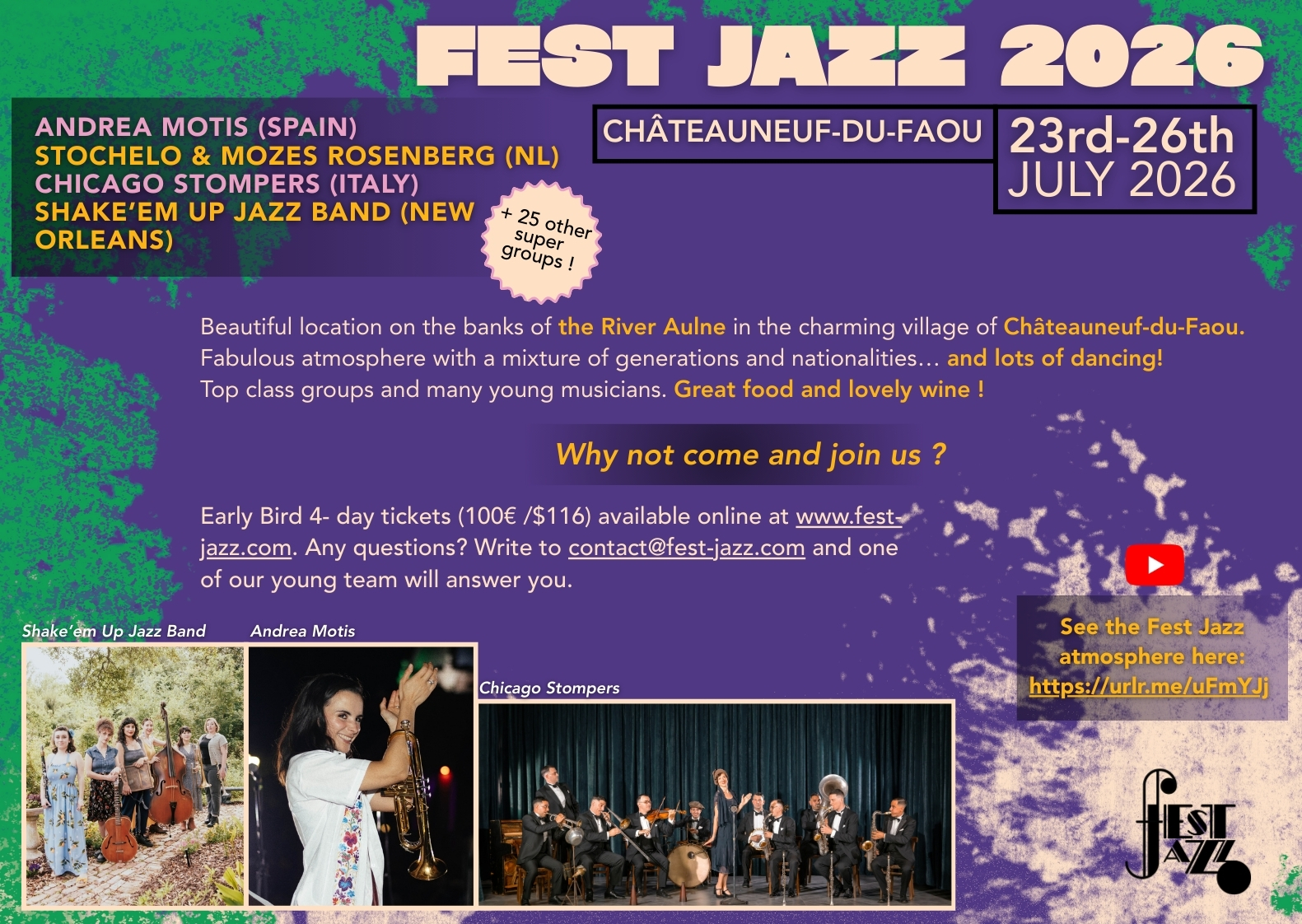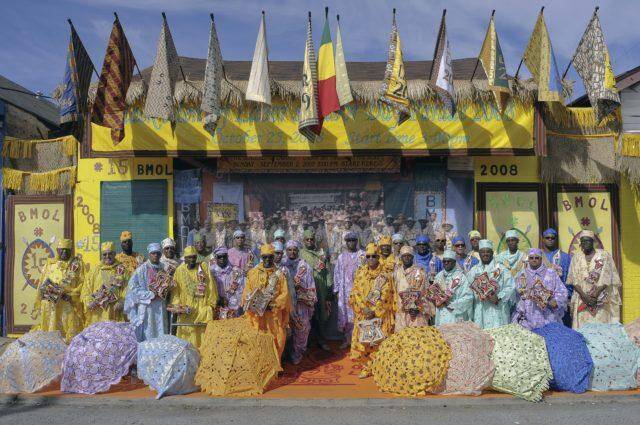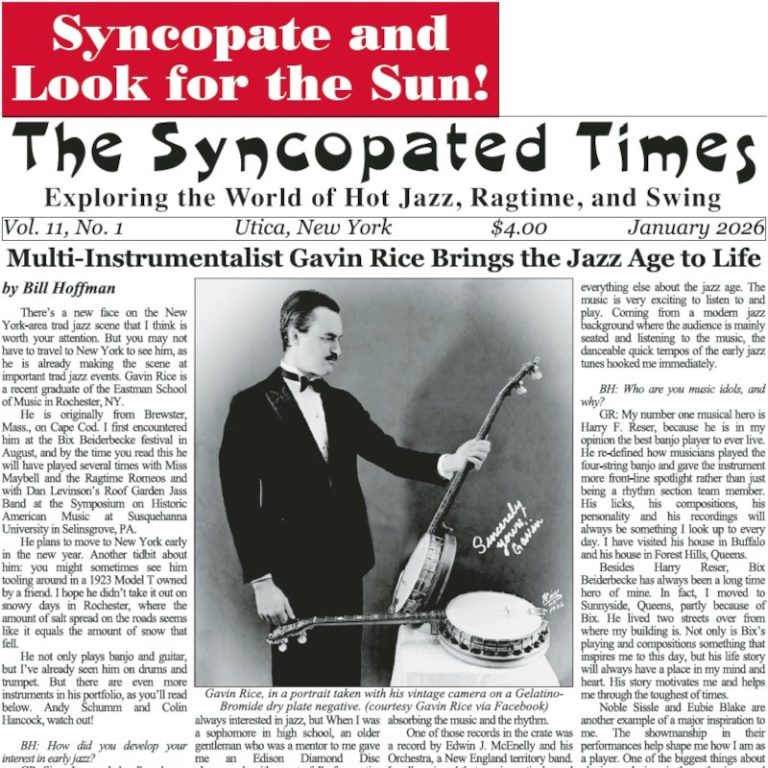
If you feel drawn to New Orleans street culture you have probably already seen a few of Eric Waters photographs. Taken at the intersection of art photography, journalism, and community memory they have sometimes even sparked debate within the community itself.
He has been invited to document the black cultural societies of New Orleans for 40 years- the Social Aid & Pleasure Clubs, the Mardi Gras Indians, The Baby Dolls, and even the elusive Skull & Bones Gangs which may predate them all. He has captured in his lens the incremental changes of fashion and behavior over time.
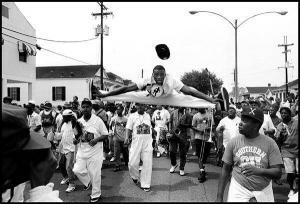
Some of his photographs are truly iconic. You can spot them in the opening theme of the HBO series Treme. A photograph of a mother dancing on her son’s coffin sparked internal debate about the raison d’être of Second Line culture in the modern city.

That mother, Lois Andrews, is interviewed for this book. She was raised and has lived immersed in the musical and parading culture of the city and another of her sons, Trombone Shorty, has become one of it’s most well-known ambassadors. Her memories are collected along with a dozen or so other interviews and essays, providing a reading experience that is at once scholarly and entertaining.
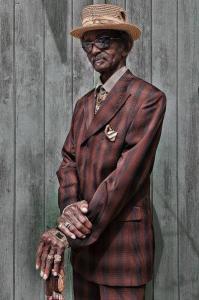
The book would be worthwhile even if it were only a collection of Eric Waters stunning photographs. He has earned a monograph and the public will benefit by being exposed to more of his work. Only a handful of the 173 images from the book appear anywhere else. That includes his own online store where you may buy a few of these images as prints.
But Waters, together with Karen Celestan, has succeeded in making this much more than a voyeuristic pleasure. The reader will feel like they finally have a grasp of what it all means, even if that meaning, and even the definitions, vary from person to person.
The book focuses specifically on Social Aid and Pleasure Clubs (SAPCs), the parading groups that march with a brass band. Distinguishing that culture from Mardi Gras Indians and other groups is helpful even though many of the most active participants also “Mask Indian” or take part in other expressive behaviors.
The SAPCs originated as mutual aid organizations and burial societies during a time period when organizations of that type were common and often tied to ethnicity. While in the North similar groups for Slavs and Scandinavians evolved into modern day insurance companies the realities of Jim Crow preserved the need for these organizations in black communities into the modern era. Most SAPCs continue to serve a community service function. If they no longer help with burial expenses, they may work with local public schools.
![By John Patrick Pemberton (d. 1914) - Work by J P Pemberton, via Metropolitan Magazine, Volume 23. Peck and Newton, 1905. Web copy via <a rel="nofollow" class="external autonumber" href="http://publicdomainclip-art.blogspot.com/2010/02/mardi-gras-new-orleans.html">[1]</a>, Public Domain, <a href="https://commons.wikimedia.org/w/index.php?curid=18864760">Link</a>](https://syncopatedtimes.com/wp-content/uploads/2018/07/JP_Pemberton_Sons_of_Hope_published_1905-276x300.jpg)
SAPCs each host an annual parade to celebrate their anniversary. Parades are on an organized schedule and can follow one of several different routes. The clubs are usually tied to a specific neighborhood. The oldest have paraded since the 1880s but new clubs come and go. Currently, there are around 38 parades, one nearly every Sunday during a parade season lasting from late August through June.
In addition to the annual parades, there are Second Lines at Jazz Funerals for important members of the community. The Jazz Funeral is distinguished by the mournful dirges played on the way to the cemetery before the more upbeat numbers played on the way back. Certain SAPCs also begin their annual parade with a dirge honoring members who have passed during the year.
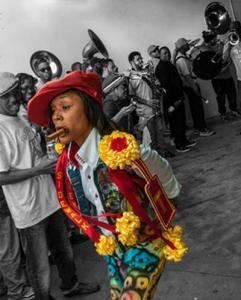

The book makes a distinction between “Second Line” as a proper noun referring to a parade hosted by a SAPC and “second line” referring to the crowd following the “first line” consisting of the band and SAPC members who make up the organized portion of the parade.
The dancing and partying both groups are doing can be referred to as the verb “second-lining”. The term “first line” is rarely if ever used but a new term, “third line”, has developed to refer to the crowds of documentarians and cultural tourists who are now regularly seen at Second Lines.
Karen Celestan is currently an English professor in Houston but was formerly the program manager for Music Rising at Tulane University in New Orleans. She has researched the African and Carribean roots of the Second Line and briefly, but fascinatingly, compares and contrasts how similar practices developed in Cuba, Haiti, Trinidad, and Brazil. The remarkably similar groups all share elements of West African origin despite being in countries where different European languages predominate. She sees second-lining as a direct and intentional act of African cultural preservation across the centuries, and many of the participants she interviews agree.

SAPCs began registering with the city in the 1880s as Congo Square was losing its importance as a meeting ground. Mardi Gras Indian gangs began around the same time as underground organizations. Both streams passed down elements of the African dances and cultural signifiers Congo Square was known for.
New Orleans received a large influx of Black Haitians, both free and enslaved, during the years around 1800. The Haitians had a more homogenous cultural background, including a greater hold on traditional language, then most American blacks.
The recency of the connection to Africa, as well as the urban setting, allowed for significantly more cultural retention in New Orleans than in other parts of the South. The parading practices of the Second Line, and some of the specific movements of the second-liners are recognizable to tourists from West Africa visiting the city today.
The Black Men of Labor, one of the most exciting and active of the newer groups (founded 1993) take cultural retention a step further by wearing modern African formal attire instead of the colorful, but Western, suits worn by most clubs.
Most of the book focuses on Second Line culture as it is today and has been within the lifetime of currently active participants. You will read first-hand accounts of Danny Barker and the Fairview Baptist Church Marching Band, of Tuba Fats, and of Lionel Battiste the parrain of the Treme Brass Band.
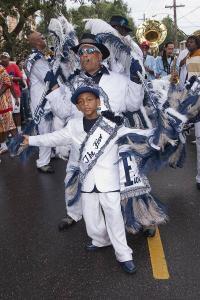
There are also interviews with people known for their dancing; Lois Andrews mentioned above, and Oliver “Squirk” Hunter from the iconic photo.
Elders and community leaders also get their say. Ronald Lewis, whose home has become a museum known as The House of Dance and Feathers, talks about memorializing a living tradition. There is an interview with a father and daughter about passing it on, and another with a son who has recently been elected to fill his father’s shoes as the sixth president in the 134-year history of the Young Men’s Olympian Jr. Benevolent Association.
He relates how there was at one time both a Sr. and Jr. division and you would pass from one to the other at age 37 but “Those who became thirty-five and older didn’t want to be known as older members of the group, so everybody started staying [in] the junior part.”
Dr. Michael G. White, a clarinetist who got his start with Doc Paulin’s band, describes the relationship of SAPCs to the brass bands they hire for parades:
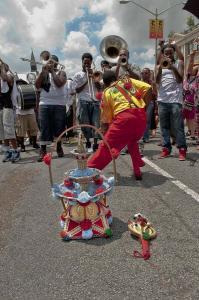
Unless one was part of that culture, it is hard to understand the power and impact that the original traditional Jazz style had in Black New Orleans during the mid-1970’s. Many, especially outside of New Orleans, erroneously viewed traditional jazz as irrelevant “old people’s music,” “primitive and archaic jazz,” “white music,” or music played by black people “tomming” to satisfy stereotyped white perceptions, but the great majority of Doc Paulin’s work was in Black community parades, funerals, and other events.
Far removed from the atmosphere of nightclubs, tourism, and the French Quarter, the brass bands remained largely Black music played for Black people. Among the many ironies surrounding these decades-old traditions is the fact that these processions were the most widely attended and socially relevant traditional jazz events in the world.
In both uptown and downtown African-American New Orleans neighborhoods, the authentic traditional Jazz style was accepted and danced to by countless thousands of all ages and levels, from the oldest of the old to the hippest of the hip to the youngest of the young. Many times I’ve seen babies too young to walk wiggle in tempo in their mother’s arms.”
The influence of jazz styles such as Bop and non-jazz influences on brass bands, creating the varied sounds we’ve come to know since the 1970s, are discussed elsewhere in the book in an interview with Gregory “Blodie” Davis of the Dirty Dozen Brass Band.

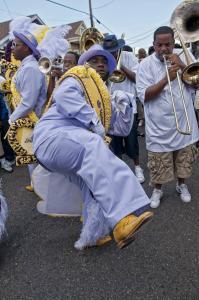
Eric Waters lost most of his photographs to the storm, so much of the book, picture as well as word, was recorded post-Katrina. This has coincided with a period when Second Line culture has seen a rebirth of respectability, intensity and healthy competition between clubs.
Clubs prepare all year for their annual parade. The book follows the process as members pick a color scheme for their marchers, discuss clothing options, imbue meaning on accessories, and plan their route.
Many with little to spare spend thousands of dollars on clothing they may only wear once. Buy they laugh off criticism pointing out how much many people spend on other hobbies that offer much less return in community engagement.
Each chapter dives into a specific aspect of the culture such as dance, accessories, clothing, or music. Conveyed by either direct interview or testimonial essay these sections have a second vital function as oral history illuminated by photographs capturing that same history. People repeatedly bring up both the presence of increasingly casual clothes and the increasing cost and work going into ever more elaborate costumes and presentations. Both trends are captured, often in the same picture.
After finishing the book you will have a sense that you could show up at a Second Line and recognize some of the people involved. In a couple of cases, that might even be true. Almost all who were asked in this book were welcoming of visitors. But, acceptance of the “third line” at Jazz Funerals and Second Lines will vary relative to the respectful behavior of those who come to watch. Parade schedules and routes are now regularly posted online and in local media. If you plan on attending a real Second Line this book will prepare you for a more meaningful experience.
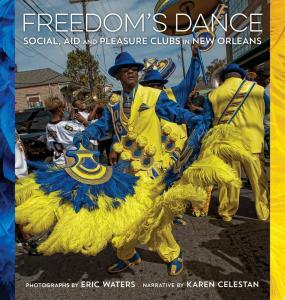 Freedom’s Dance: Social Aid and Pleasure Clubs in New Orleans
Freedom’s Dance: Social Aid and Pleasure Clubs in New Orleans
Photographs by Eric Waters/ Narrative by Karen Celestan
248 pages / 10.00 x 9.50 inches / 143 color photos, 30 b&w photos, 6 line drawings Hardcover / 9780807168837 / February 2018
We have included the photographs in this review for the purposes of criticism, comment, teaching, scholarship, and educational research under Section 107 of the U.S. Copyright Act. Please be considerate of the working artist, Eric Waters, who retains ownership of these images. http://www.ericwatersphotography504.com/
Joe Bebco is the Associate Editor of The Syncopated Times and Webmaster of SyncopatedTimes.com

